
Have you ever heard of a soft opening? Restaurants use the strategy all the time.
In the restaurant world, a soft opening is a time when a brand new eatery opens its doors to a select group of people for a night of dining before the official opening. They’re usually held without advertising or the traditional fanfare associated with an opening night.
You’re likely patiently wondering why in the world we’re talking about restaurant soft openings in an article about capital campaigns, but let me explain.
Generally speaking, soft openings are to new restaurants what quiet phases are to capital campaigns.
A capital campaign’s quiet phase is the stage of a capital campaign prior to the campaign’s rollout. Nonprofits typically raise 50-70% of their overall goal during this time. Those donations usually come in the form of major gifts from:
- Major donors
- Government agencies
- Corporations
Given how much of the campaign total is usually raised during the phase, it’s easy to see why implementing actionable and well-thought-out strategies is paramount.
Read on to discover six ways you can make the most of your next capital campaign quiet phase!
In this article, we’ll be covering the following tips:
- Develop a cohesive asking strategy.
- Be purposeful when selecting prospects.
- Perfect your prospect profiles.
- Engage prospects in innovative ways.
- Draft a perfect case statement.
- Close with a strong kickoff event.
And if you’re looking for more complete coverage of the entire capital campaign process, you can head on over to DonorSearch’s guide.
Let’s get started!
1. Develop a cohesive asking strategy.
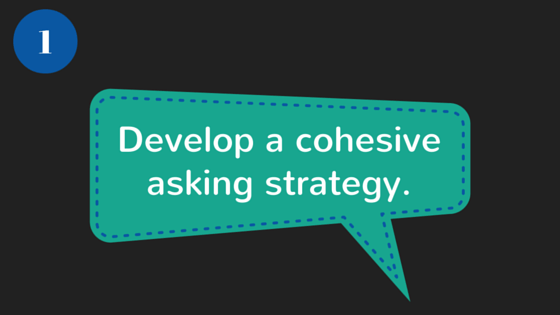
It’s no secret that the quiet phase is all about securing major gifts.
Capital campaigns are huge endeavors, often with lofty goals. The quiet phase is responsible for shouldering a large percentage of the fundraising burden.
Before your campaign is even officially public knowledge, it’s the job of the quiet phase to raise the majority of your goal total.
In order to successfully execute a quiet phase that almost reaches the campaign goal, your organization has to have a cohesive asking strategy.
Essentially, you’ll be getting the whole team on the same page so that you’re presenting a unified front when you solicit large gifts from donors.
Your capital campaign team is going to be quite diverse and large, including but not limited to the following individuals and/or groups:
- Major gifts officer(s)
- Board of directors
- Proposal writer(s)
- Direct mail coordinator(s)
- Website designer and IT support
- Volunteer coordinator(s)
- Prospect researcher(s)
- Support staff
As you can likely tell, a team of that size is a lot to manage without a proper, unifying strategy.
When it comes to the quiet phase specifically, that strategy will boil down to ensuring that all team members who are soliciting major gifts are working with a similar presentation in terms of the campaign’s:
- End goal
- Summary materials
- Messaging
- And more!
Just remember — With major gift solicitation, the ask has to be highly personal. However, when the major gift ask is part of the larger capital campaign, there has to be an underlying framework that holds all these efforts together. That’s where your unified asking strategy comes into play.
2. Be purposeful when selecting prospects.
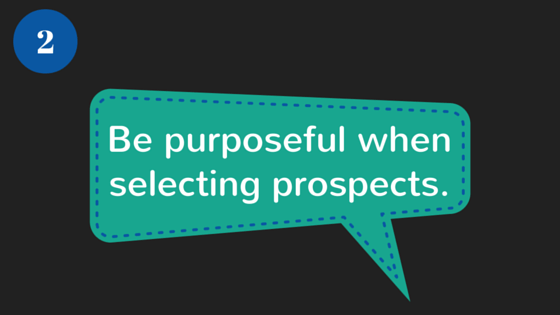
Capital campaign fundraising can be broken down into a hierarchy of gifts:
- A selection of lead gifts that constitutes a major portion of your funds.
- A slightly larger selection of major gifts from some of your most loyal major donors.
- A large selection of mid-level to small gifts (gathered during the campaign’s public phase).
You likely know where to look for numbers two and three on the gift hierarchy list, but number one is where you’ll have to be more inventive and start looking outside your immediate circle.
A quiet phase doesn’t consist of your organization soliciting just any old prospects; it requires a search for high-quality, major-gift-qualified prospects.
Where are you looking for such prospects? You’ve surely already performed a screening, but have you thought creatively about where else you should be searching?
What about your feasibility study participants?
Your feasibility study participants were selected for a reason.
They are influential members of your community who weighed in on the very decision to run a capital campaign in the first place.
Of the study participants who were enthusiastic about your campaign, see who fits your nonprofit’s major donor profile.
On a grander scale, the quiet phase is the ideal time to secure gifts from corporations in addition to individuals.
On the corporate donor level, you’ll mostly be looking for local companies. A local company is more likely to be invested in the good work you’re doing for their immediate community than a company in some random city across the country.
Just remember — You want a purposeful and deliberate approach to finding prospects, but that doesn’t mean your search has to be narrow. Aim for a happy medium that makes the most effective use of your team’s time during this pivotal phase.
3. Perfect your prospect profiles.

Before you officially start to cultivate your pool of quiet phase prospects and after you’ve narrowed down your list to the right group of candidates, you’ll want to make sure your prospect profiles are in tip-top shape.
Why?
Every little detail helps when it comes to cultivating and soliciting major gifts. And a capital campaign’s quiet phase is crunch time!
There are countless scenarios where a more well-rounded prospect profile can come in handy.
Let’s explore a few of those scenarios.
In one instance, you learn that Prospect Patty is the coworker of one of your board members.
With that knowledge, your team is better equipped to truly connect with Patty. Instead of leading with a cold outreach, you can have your board member make the introduction, starting the relationship off with an early foundation of trust.
Plus, that same company might even offer matching gifts. If you can secure a major gift from Patty and effectively promote matching gifts to her, your nonprofit could be twice as close to its quiet phase goal. (Learn more about matching gifts here).
Are you starting to see the benefits?
Let’s explore one more scenario for good measure. Imagine that you have a fully decked out prospect profile on Supporter Sam.
Armed with a complete profile, you have a solid understanding of Sam’s philanthropic and wealth markers, like his real estate holdings. Using the value of his real estate holdings as a starting point, you can put on your detective’s hat and backtrack to estimate predicted wealth.
Then, couple that predicted wealth with your knowledge of his charitable behavior and you’re one step closer to making the ideal ask when the time comes.
And those are just two of the many scenarios that can play out with the right donor data behind your team.
Just remember — You can never have too much donor data. Take it all in and leverage it for better results across the board but especially during the quiet phase.
4. Engage prospects in innovative ways.
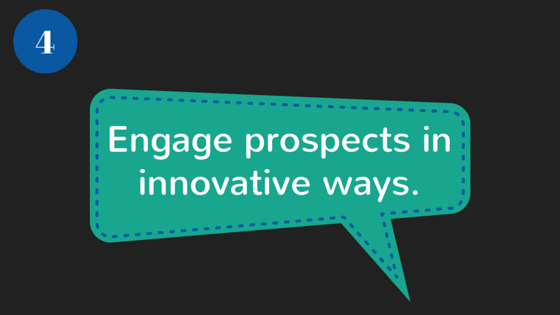
The previous section spoke to this sentiment somewhat, but it warrants its own discussion here.
What do you do when you have a carefully curated group of high-quality prospects and a treasure trove of information about them? You use it!
Meaningful engagement, both before and after solicitation, can go a long way toward fostering a strong relationship with a donor.
For the purposes of this discussion, let’s home in on what will constitute most of your quiet phase. Or rather, let’s focus on engagement during cultivation.
Get your team together and brainstorm some out-of-the-box ideas for engaging with your quiet phase prospects. The sky’s the limit (within in reason, of course)!
Thanks to your prospect research, you’ve been given a window into your candidate’s philanthropic interests. Peer through the window!
You might, for instance, learn that one of your prospects is a top volunteer at another nonprofit in your community. The best way to engage with that prospect might be to invite them to a volunteering opportunity.
It could sound counterintuitive to ask a potential major donor if they’d also be open to contributing additional hours to your cause, but that first hand experience with your team might be just what they need to decide to donate.
Just remember — Fundraisers with limited time and resources don’t always get to be as thorough in their cultivation of prospects as they’d like to be. With a quiet phase, that thoroughness has to be a priority. And part of that should certainly involve creative engagement strategies.
5. Draft a perfect case statement.
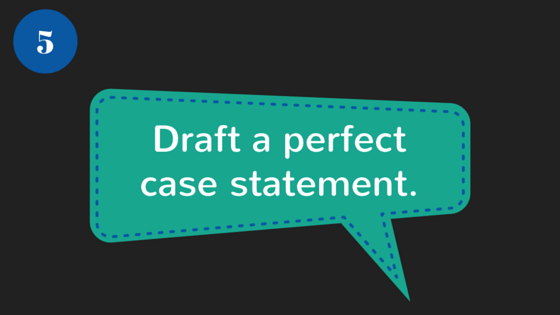
Think of your case statement as your capital campaign summary.
It’s a brief document that gets down to brass tacks and answers all the immediate questions a potential donor might have about your campaign, including:
- What the funds are going towards?
- Why the project is necessary?
- What your organization has accomplished in the past?
- What you aim to accomplish in the future?
The case statement is not a long or extensive document.
It’s a supplement to the great fundraising efforts you’re already making. It’s a leave behind document after a major gift meeting, or maybe even a hand out when you encounter a potential giving candidate.
Just remember — Once you’ve drafted and designed the ideal case statement, let the information guide the development of your remaining marketing materials. Building out from one document will help make sure that your messaging stays centralized as you expand the scope of your marketing.
6. Close with a strong kickoff event.
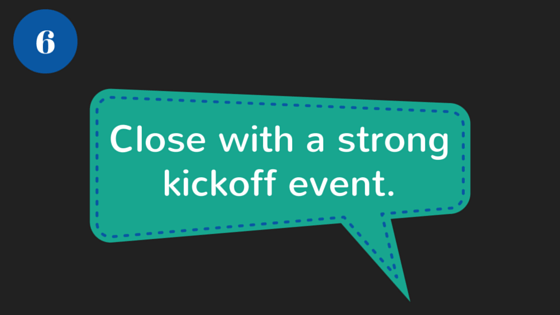
This point is kind of a cheat because the kickoff event is really what bridges the gap between the quiet and public phases of your event.
The kickoff is when you introduce your campaign to the world. All the hard work from the quiet phase will be on display, and it’ll be time to get your broader donor pool involved.
Ensure that your kickoff is a night to remember. It’s all the better if you can find a way to connect the event directly back into the work you’re doing.
For instance, if your church has organized a capital campaign to fundraise for the money needed to remodel the chapel, you should host the kickoff event at the site you’re looking to remodel. The more concrete and real you can make the campaign’s goal, the more successful you’ll be at fundraising.
At the event itself, get to fundraising! Use a mix of strategies to start the public phase off strong.
Just remember — The kickoff event is the perfect way to shut the door to your quiet phase while opening a window to your public phase.
A capital campaign’s quiet phase can be make or break. Just like a restaurant’s soft opening, it is a great indicator of what’s to come. Make sure you set the right kind of precedent by implementing the above strategies, and ideas like them, into your capital campaign plans.
Business & Finance Articles on Business 2 Community
(163)
Report Post



